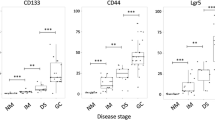Abstract
We histopathologically re-evaluated the histogenesis of gastric carcinomas from comparative studies between Helicobacter pylori-positive and H. pylori-negative cases using the gastritis score from the Updated Sydney System. The incidence of H. pylori-negative gastric carcinomas was 3.11% (12/386); they are likely to develop in the fundic gland mucosa, and show a gastric phenotype by mucin immunohistochemistry. Even in cases of completely gastric and predominantly gastric phenotypes, CDX2 protein was expressed in most cases (90.9% of pT1 and 100% of pT2-3), indicating a possibility that intestinalization of carcinoma cells occurs independently of the background mucosa. Regarding the degree of gastritis of background mucosa surrounding 143 H. pylori-positive differentiated-type adenocarcinomas, the mean score ranged from 1.497 to 1.713. Our data support the hypothesis that intestinal metaplasia is not a precancerous but a paracancerous lesion, and most gastric adenocarcinomas develop in mildly to moderately atrophic mucosa with H. pylori-infection, i.e., ongoing atrophy.





Similar content being viewed by others
References
Lauren P (1965) The two histological main types of gastric carcinoma: diffuse and so-called intestinal-type carcinoma. An attempt at a histo-clinical classification. Acta Pathol Microbiol Scand 64:31–49
Nakamura K, Sugano H, Takagi K (1968) Carcinoma of the stomach in incipient phase: its histogenesis and histological appearances. Gann 59:251–258
Jarvi O, Lauren P (1951) On the role of heterotopias of the intestinal epithelium in the pathogenesis of gastric cancer. Acta Pathol Microbiol Scand 29:26–44
Tatematsu M, Ichinose M, Miki K, Hasegawa R, Kato T, Ito N (1990) Gastric and intestinal phenotypic expression of human stomach cancers as revealed by pepsinogen immunohistochemistry and mucin histochemistry. Acta Pathol Jpn 40:494–504
Correa P (1988) A human model of gastric carcinogenesis. Cancer Res 48:3554–3560
Marshall W (1984) Unidentified curved bacilli in the stomach of patients with gastritis and peptic ulceration. Lancet 323:1311–1315. doi:10.1016/S0140-6736(84)91816-6
Satoh K, Kimura K, Yoshida Y, Ota Y, Taniguchi Y, Kihira K et al (1994) Relationship between Helicobacter pylori and atrophic gastritis. Eur J Gastroenterol Hepatol 6(Suppl 1):S85–S88
Parsonnet J, Friedman G, Vandersteen D, Chang Y, Vogelman J, Orentreich N et al (1991) Helicobacter pylori infection and the risk of gastric carcinoma. N Engl J Med 325:1127–1131
Nomura A, Stemmermann G, Chyou P, Kato I, Perez-Perez G, Blaser M (1991) Helicobacter pylori infection and gastric carcinoma among Japanese Americans in Hawaii. N Engl J Med 325:1132–1136
Forman D, Newell D, Fullerton F, Yarnell J, Stacey A, Wald N et al (1991) Association between infection with Helicobacter pylori and risk of gastric cancer: evidence from a prospective investigation. BMJ 302:1302–1305
Asaka M, Takeda H, Sugiyama T, Kato M (1997) What role does Helicobacter pylori play in gastric cancer? Gastroenterology 113:S56–S60
Hirahashi M, Yao T, Matsumoto T, Nishiyama K, Oya M, Iida M et al (2007) Intramucosal gastric adenocarcinoma of poorly differentiated type in the young is characterized by Helicobacter pylori infection and antral lymphoid hyperplasia. Mod Pathol 20:29–34. doi:10.1038/modpathol.3800714
Uemura N, Okamoto S, Yamamoto S, Matsumura N, Yamaguchi S, Yamakido M et al (2001) Helicobacter pylori infection and the development of gastric cancer. N Engl J Med 345:784–789. doi:10.1056/NEJMoa001999
Japanese Gastric Cancer Association (1998) Japanese classification of gastric carcinoma (2nd English ed). Gastric Cancer 1:10–24
Schlemper RJ, Riddell RH, Kato Y, Borchard F, Cooper HS, Dawsey SM et al (2000) The Vienna classification of gastrointestinal epithelial neoplasia. Gut 47:251–255. doi:10.1136/gut.47.2.251
Dixon M, Genta R, Yardley J, Correa P (1996) Classification and grading of gastritis. The updated Sydney system. International workshop on the histopathology of gastritis, Houston 1994. Am J Surg Pathol 20:1161–1181
Sasaki I, Yao T, Nawata H, Tsuneyoshi M (1999) Minute gastric carcinoma of differentiated type with special reference to the significance of intestinal metaplasia, proliferative zone, and p53 protein during tumor development. Cancer 85:1719–1729. doi :10.1002/(SICI)1097-0142(19990415)85:8≤1719::AID-CNCR11≥3.0.CO;2-V
Egashira Y, Shimoda T, Ikegami M (1999) Mucin histochemical analysis of minute gastric differentiated adenocarcinoma. Pathol Int 49:55–61. doi:10.1046/j.1440-1827.1999.00824.x
Wada R, Yamaguchi T, Tanizaki T (2005) Mucin phenotypic expression and p53 gene abnormality of gastric super-minute well-differentiated adenocarcinoma: re-evaluation with relationship between histogenesis of well-differentiated adenocarcinoma and intestinal metaplasia in distal stomach. J Carcinog 4:14. doi:10.1186/1477-3163-4-14
Tsukashita S, Kushima R, Bamba M, Sugihara H, Hattori T (2001) MUC gene expression and histogenesis of adenocarcinoma of the stomach. Int J Cancer 94:166–170. doi:10.1002/ijc.1460
Koseki K, Takizawa T, Koike M, Ito M, Nihei Z, Sugihara K (2000) Distinction of differentiated type early gastric carcinoma with gastric type mucin expression. Cancer 89:724–732. doi :10.1002/1097-0142(20000815)89:4≤724::AID-CNCR2≥3.0.CO;2-4
Shiroshita H, Watanabe H, Ajioka Y, Watanabe G, Nishikura K, Kitano S (2004) Re-evaluation of mucin phenotypes of gastric minute well-differentiated-type adenocarcinomas using a series of HGM, MUC5AC, MUC6, M-GGMC, MUC2 and CD10 stains. Pathol Int 54:311–321. doi:10.1111/j.1440-1827.2004.01625.x
Chawengsaksophak K, James R, Hammond VE, Kontgen F, Bech F (1997) Homeosis and intestinal tumours in Cdx2 mutant mice. Nature 386:84–87. doi:10.1038/386084a0
Bai Y, Yamamoto H, Akiyama Y, Tanaka H, Takizawa T, Koike M et al (2002) Ectopic expression of homeodomain protein CDX2 in intestinal metaplasia and carcinomas of the stomach. Cancer Lett 176:47–55. doi:10.1016/S0304-3835(01)00753-4
Kushima R, Jancic S, Hattori T (1993) Association between expression of sialosyl-Tn antigen and intestinalization of gastric carcinomas. Int J Cancer 55:904–908
Yamachika T, Inada K, Fujimitsu Y, Nakamura S, Yamamura Y, Kitou T et al (1997) Intestinalization of gastric signet ring cell carcinomas with progression. Virchows Arch 431:103–110. doi:10.1007/s004280050075
Sasaki A, Kitadai Y, Ito M, Tanaka S, Yoshihara M, Haruma K et al (2004) Mucin phenotype and background mucosa of intramucosal differentiated-type adenocarcinoma of the stomach. Oncology 66:379–387. doi:10.1159/000079486
Kawachi H, Takizawa T, Eishi Y, Shimizu S, Kumagai J, Funata N et al (2003) Absence of either gastric or intestinal phenotype in microscopic differentiated gastric carcinomas. J Pathol 199:436–446. doi:10.1002/path.1323
Hattori T (1986) Development of adenocarcinomas in the stomach. Cancer 57:1528–1534. doi :10.1002/1097-0142(19860415)57:8≤1528::AID-CNCR2820570815≥3.0.CO;2-3
Author information
Authors and Affiliations
Corresponding author
Rights and permissions
About this article
Cite this article
Kakinoki, R., Kushima, R., Matsubara, A. et al. Re-evaluation of Histogenesis of Gastric Carcinomas: A Comparative Histopathological Study Between Helicobacter pylori-Negative and H. pylori-Positive Cases. Dig Dis Sci 54, 614–620 (2009). https://doi.org/10.1007/s10620-008-0389-5
Received:
Accepted:
Published:
Issue Date:
DOI: https://doi.org/10.1007/s10620-008-0389-5




